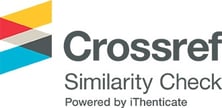FAKTOR PENENTU TERBENTUKNYA BUDAYA KERJA INOVATIF (STUDI PADA POLITEKNIK HARAPAN BERSAMA)
DOI:
10.33395/owner.v7i2.1364Keywords:
Innovation, Culture, Transformation, LeadershipAbstract
Educational institutions are institutions that provide services to consumers in the form of services, the results of which are not visible, such as manufacturing companies that can produce products that are visible when delivered to the public. Educational institutions in order to keep abreast of changing times, educational institutions are required to innovate. This research was conducted at the Polytechnic Harapan Bersama with a total of 225 respondents. Statistical analysis test performed with the PLS test with a SmartPLS 3.0. The existence of leadership transformation influences innovative work culture successfully mediated in part by work autonomy because without going through work autonomy there. Without going through work autonomy, there is leadership transformation that influences existing innovative culture, astests. Supportive management failed to become a mediating variable because supportive management has no effect on innovative work culture as evidenced by the statistical tests conducted
Downloads
Plum-X Analityc
References
Afsar, B., Badir, Y.F. dan Bin Saeed, B. (2014), “Transformational leadership and innovative work behaviour”, Industrial Management & Data Systems, Vol. 114 No. 8, pp. 1270-1300.
Alfian, M. Firmansyah, M.S. Purwitasari, E. dan Purnama, I. (2020). Faktor Yang Mempengaruhi Kinerja Karyawan Dengan Gender Sebagai Variabel Moderasi (Studi Pada Perguruan Tinggi di Kota Tegal). Monex: Journal of Accounting Research, 9(2), 152-157.
Alpkan, L., Bulut, C., Gunday, G., Ulusoy, G. and Kilic, K. (2010), “Organisational support for intrapreneurship and its interaction with human capital to enhance innovative performance”, Management Decision, Vol. 48 No. 5, pp. 732-755.
Al-Husseini, S., & Elbeltagi, I. (2016). Transformational leadership and innovation: A comparison study between Iraq’s public and private higher education. Studies in Higher Education, 41(1), 159–181.
Amankwaa, A., Gyensare, M. A., dan Susomrith, P. (2019). Transformational leadership with innovative behaviour: Examining multiple mediating paths with PLS-SEM. Leadership & Organization Development Journal.
Anderson, N., Potoc?nik, K., dan Zhou, J. (2014). Innovation and creativity in organizations: A state-of-the-science review, prospective commentary, and guiding framework. Journal of Management, 40(5), 1297–1333.
Baer, M., Evans, K., Oldham, G. R., dan Boasso, A. (2015). The social networkside of individual innovation: A meta-analysis and path-analytic inte-gration. Organizational Psychology Review, 5(3), 191–223.
Burns, J. M. (1978). Leadership. New York: Harper and Row.
Bysted, R. (2013), “Innovative employee behaviour: the moderating effects of mental involvement and job satisfaction on contextual variables”, European Journal of Innovation Management, Vol. 16 No. 3, pp. 268-284.
Carvalho VS dan MJ Chambel (2015) Perceived high-performance work systems and subjective well-being: work-to-family balance and well-being at work as mediators. Journal of Career Development 43(2), 116–129.
Denti, L., dan Hemlin, S. (2012). Leadership and innovation in organizations: A systematic review of factors that mediate or moderate the relationship. International Journal of Innovation Management, 16(03), 1240007.
Elkins, T., dan Keller, R. T. (2003). Leadership in research and development organizations: A literature review andcconceptual framework. The Leadership Quarterly, 14(4–5), 587–606.
Grant, A.M. and Berry, J.W. (2011), “The necessity of others is the mother of invention: Intrinsic and prosocial motivations, perspective taking, and creativity”, The Academy of Management Journal, Vol. 54 No. 1, pp. 73-96.
Hartono, J., & Abdillah, W. (2009). Konsep dan aplikasi PLS (partial least square) untuk penelitian empiris. Edisi I, BPFE, Yogyakarta.
Hunter, S.T. dan Cushenbery, L. (2011), “Leading for innovation: direct and indirect influences”, Advances in Developing Human Resources, Vol. 13 No. 3, pp. 248-265.
Indrawati, D. A. (2013). Pengaruh Kepuasan Kerja Terhadap Kinerja Karyawan Dan Kepuasan Pelanggan Pada Rumah Sakit Swasta Di Kota Denpasar. Jurnal Manajemen, Strategi Bisnis Dan Kewrirausahaan, 7(2), 2.
Isaken, S.G. dan Laver, K.J. (2002), “The climate for creativity and change in teams”,Creativity and Innovation Management, Vol. 11 No. 1, pp. 74-86.
Latan, H. & Ghozali, I. (2012). Partial least square: Konsep, teknik dan aplikasi SmartPLS 2.0 M3. Semarang: Badan Penerbit Universitas Diponegoro.
Potoc?nik, K., dan Anderson, N. (2016). A constructively critical review of change and innovation-related concepts: Towards conceptual and operational clarity. European Journal of Work and Organizational Psy-chology, 25(4), 481–494.
Pratiwi, Agustin, Mudji Kuswinarno dan Faidal. (2013). “Pengaruh Kompensasi terhadap Kinerja Karyawan Pada PT. Pos Indonesia (Persero) Kantor Cabang Bangkalan.” Jurnal Pengaruh Kompensasi terhadap Kinerja Karyawan. Universitas Trunojoyo Madura (UTM)
Prieto-Pastor, I. and Martin-Perez, V. (2015), “Does HRM generate ambidextrous employees for ambidextrous learning? The moderating role of management support”, The International Journal of Human Resource Management, Vol. 26 No. 5, pp. 589-615.
Schyns, B. dan Sanders, K. (2007), “In the eyes of the beholder: personality and the perception of leadership”, Journal of Applied Social Psychology, Vol. 37 No. 1, pp. 2345-2363.
Supomo, R dan Nurhayati, Eti. (2018). Manajemen Sumber Daya Manusia, Yrama Widya, Bandung.
Van Dorssen-Boog, P., De Jong, J., Veld, M., dan Van Vuuren, T. (2020). Self-leadership among healthcare workers: A mediator for the effects of job autonomy on work engagement and health. Frontiers in psychology, 11, 1420.
Wattoo, M. A., Zhao, S., dan Xi, M. (2020). High?performance work systems and work–family interface: job autonomy and self?efficacy as mediators. Asia Pacific Journal of Human Resources, 58(1), 128-148.
Widodo, S. E. (2015). Manajemen Pengembangan Sumber Daya Manusia. Yogyakarta: Pustaka Pelajar
Wong, K. K. K. (2013). Partial least squares structural equation modeling (PLS-SEM) techniques using SmartPLS. Marketing Bulletin, 24(1), 1-32.
Yukl, G. A. (1989). Leadership in organisations (2nd ed.). Englewood Cliffs, NJ: Prentice-Hall.
Zahra, S. A. (1991). Predictors and financial outcomes of corporate entrepreneurship: An exploratory study. Journal of Business Venturing, 6(4), 259-285.
Downloads
Published
How to Cite
Issue
Section
License
Copyright (c) 2023 Erni Unggul Sedya Utami, Bahri Kamal

This work is licensed under a Creative Commons Attribution-NonCommercial 4.0 International License.
















